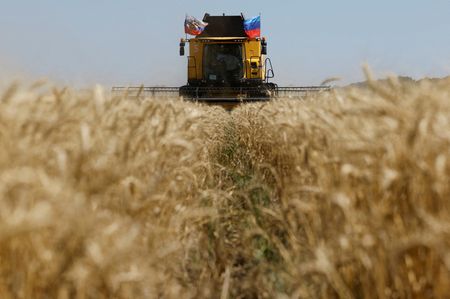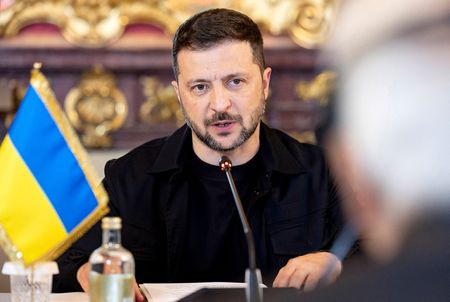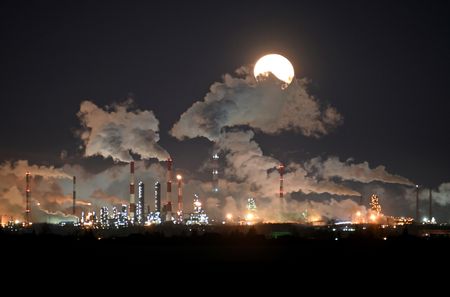STAROBILSK DISTRICT, Russian-controlled Ukraine (Reuters) -Luhansk, one of four regions of Ukraine that Russia has claimed as its own since going to war in 2022, expects to double its wheat harvest this year and send some for export, local officials say.
The rapid rise in production reflects the regions’ growing role in Russia’s agriculture sector and shows how the world’s largest wheat exporter is incorporating them into its strategy.
Last year Luhansk, Donetsk, Kherson and Zaporizhzhia regions – referred to by Russia as its “new territories” but still internationally recognised as Ukrainian – supplied about 3% of Russia’s grain crop, the Agriculture Ministry said.
Without that, a poor national harvest – down 14% due to bad weather in southern Russia – would have been even worse.
“This year we are planning to harvest about one million tons of grain, mostly wheat,” Leonid Pasechnik, head of the Russian-installed administration of Luhansk, told reporters including Reuters last month.
“We planned to do the same last year but with very bad weather conditions, first spring frosts, the drought, we collected only half a million.”
At current market prices offered for free-on-board (FOB) delivery in Russia in August, this year’s estimated 1 million ton crop would cost about $230 million. Before pro-Russian separatists took partial control of Luhansk, the region had produced 1.3 million tons of grain, mostly wheat, in 2013.
Ukraine considers all grain produced in the four regions and Crimea – annexed by Russia in 2014 – to have been stolen by Moscow, and plans to ask its Western allies to sanction importers of it. Kyiv says its intelligence services have discovered the Ukrainian wheat is mixed with Russian at Black Sea ports and sent for export.
“Taking this season into account, we estimate that Russia has stolen 15 million tons of Ukrainian grain since the start of the full-scale war,” Ukraine’s Deputy Economy Minister Taras Vysotskiy told Reuters.
In one case, Ukraine called on the European Union to slap sanctions on Bangladesh over purchases of wheat it said came from Russian-controlled regions, but the EU has not done so.
The European Commission did not respond to a Reuters request for comment.
Traders tell Reuters that it is impossible to track the origin of wheat once it is mixed.
Russian officials have not commented on the legal status of grain, collected in the “new territories”. Russia’s official statistics agency, as well as leading consultancies, do not include the regions’ crops in their reports though the Agriculture Ministry does, creating some discrepancies over their status.
FARM VISIT
On a visit to a farm in the Starobilsk district to mark the start of the harvesting campaign last month, Pasechnik hopped off a U.S.-made harvester flying a Russian flag and shook hands with farmers.
“May God grant us all victory and peace. This is what we should be focusing on, not war,” he told them in a wheat field at the Sasha farm, less than 100 km (62 miles) from the front line.
Luhansk, the only one of the four regions where Russia says it has full territorial control after three-and-a-half years of war, has increased the seeded area by 10% this year as unused lands go back into circulation, the local officials said.
The town of Starobilsk saw intense fighting in the early days of the war but has been under Russian control since March 2022. It is surrounded by fertile fields where farmers cultivate wheat, other grains and sunflowers.
Moscow has allocated 8 billion roubles ($102 million) annually to support farmers in the “new territories”. It also lifted an export tax on wheat produced in these regions. This makes the grain cheaper, facilitating exports.
“Due to the duty-free regime, our products are more attractive to traders from other regions,” Evgeny Sorokin, agriculture minister in the Russian-installed administration of the Luhansk region, told Reuters.
Sorokin, appearing with Pasechnik at a ceremony for the start of harvesting, said that better margins due to the absence of the export tax have enabled farmers to purchase modern equipment, fertilizers, and fuel. Farmers and field workers at the event declined to speak to Reuters.
The weather in Luhansk this year is better than in the neighbouring Rostov region of Russia, where drought threatens to destroy up to 30% of crops, although Sorokin mentioned there was not enough moisture in the soil in Luhansk as well.
“Two-thirds of the territory of the republic consists of highly productive arable black earth. The potential of the republic is large. What we are discussing today, one million tons of grain, is by no means the limit,” Sorokin said.
He estimated that the total arable area in Luhansk equals 1.2 million hectares, while 0.7 million hectares were seeded this year, suggesting that the region has the potential to quickly increase the seeded area.
Russia has asked all landowners in the “new territories” to register with the Russian land registry before 2028. Many farmers fled the area with their fields now unused, while 20,000 hectares in Luhansk region were still strewn with landmines as of last December, according to Sorokin.
($1 = 78.4500 roubles)
(Writing by Gleb Bryanski; Additional reporting by Pavel Polityuk in Kyiv and Julia Payne in Brussels; Editing by Mark Trevelyan and Andrew Cawthorne)











